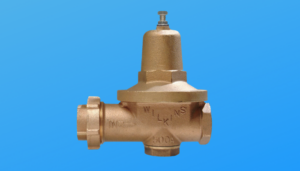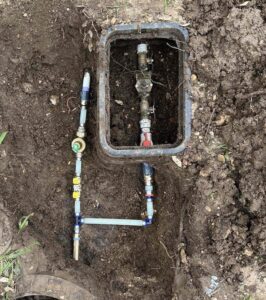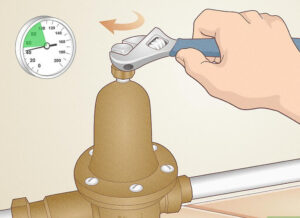Pressure Reducing Valves, abbreviated as PRV, are valves that decrease incoming water pressure into your home. Although high water pressure is often seen as a positive, most homes should have a maximum PSI of 75. Anything above 75 can be detrimental to your comfort and home. Normal operating pressure is 60-65. This level of water pressure is more comfortable and better suited for your home’s infrastructure. Because of this, many homeowners choose to add PRVs to their homes for the health of their fixtures such as water heaters and RO systems.

How Does A Pressure Reducing Valve Work?
PRVs are located near the shutoff valve on your main water supply line where the water enters your house. A PRV’s main job is to keep the water pressure stable, even when water events change the pressure. For example, fire fighting trucks use a ton of water to fight fires. Because of this, it can affect the water supply levels and sometimes disturb the existing water supply. A pressure reducing valve prevents the water from flowing backwards into your home’s water.
The easiest way to determine if your Pressure Reducing Valve is working correctly would be to locate the arrow on the valve. This arrow indicates the direction of the water flow. This arrow should be pointing from the meter to your home or commercial property.
Another component to check is the material of your PRV. Instead, ensure your valve is made fully of brass. Many home builders use lower-quality valves; PRVs with plastic caps will often not even last a year. Finally, the reason many PRVs fail is that they are located in the ground which can be very corrosive.

How to Adjust Pressure Reducing Valve

The 9 steps needed to improve your pressure from the PRV
- Find the water pressure regulator on your supply line.
- It should look like a large brass bell sitting on more brass piping.
- Check out the specifications on the water pressure regulator.
- Is it made for 50 psi? 70 psi?
- Attach a water pressure gauge to an outdoor faucet.
- These are readily available online or in hardware stores.
- Loosen the locknut with a wrench.
- This will be the gray nut on top of the unit.
- Turn the bolt clockwise to increase the pressure.
- Pressure less than 40 psi should be turned up.
- Turn the bolt counterclockwise to reduce the pressure.
- Your home’s psi should never be more than 60-65 psi
- Check the water pressure gauge again.
- This is crucial to making sure the adjustment works correctly.
- Tighten the locknut to secure the water pressure regulator.
- Careful not to overtighten and strip the bolt.
- Call a professional if your water pressure doesn’t change.
- Reliant plumbing replaces PRV’s all the time! Rely on a trusted local plumber like Reliant Plumbing the next time you need help with a PRV.
4 warning signs that it is time to replace your PRV
Changing Water Pressure: You may notice that as you take a shower or do your dishes there will initially be high water pressure, but then it drops off starkly.
Hammering Pipes: If your pipes are extremely noisy and make hammering sounds while your water is on, the water pressure is too high for your infrastructure to handle.
Leakage: Do you notice water around your water meter? There may be an issue with your PRV.
Bolt Issues: If you adjust the pressure using your Pressure Reducing Valve and the bolt on the valve breaks, it’s time to replace it.
When Should You Replace Your PRV?
You should always replace your PRV when you notice any of the above issues, but depending on the quality of your valve, you may want to replace it every three to six years. The best PRV’s are made of solid brass, no plastic parts. Keep in mind that you won’t want to replace your valve within its first year of being installed due to a risk for corrosion.
Benefits of a PRV
Besides improving the comfort level of your water when your water pressure is too high, PRVs have a few additional benefits. Adding a PRV can reduce water waste and improve energy savings. Most of our clients experience savings on their utility bill when less water is rushing through the pipes for the same effect. In fact, our plumbers agree that high water pressure is the leading cause of slab leaks, broken fixtures (as many can only manage certain pressure levels), leaky faucets, broken pipes, water heaters, and water softeners. Just like blood pressure in your veins, high water pressure can weaken your pipes ability to hold the water.
Austin’s History with PRV’s – Rebate Available to Austinites
Unfortunately, the city can increase your water pressure at any time to accommodate new construction. In fact, having a PRV has been mandatory for all homes in Austin with a PSI of 80 since 1980; however, each jurisdiction can override that regulation if they choose to. Homeowners in Austin can take advantage of a PRV rebate, provided by the City of Austin.
If you’re in the Austin or San Antonio areas, choose Reliant Plumbing for all of your Pressure Reducing Valve needs. Give us a call today!

